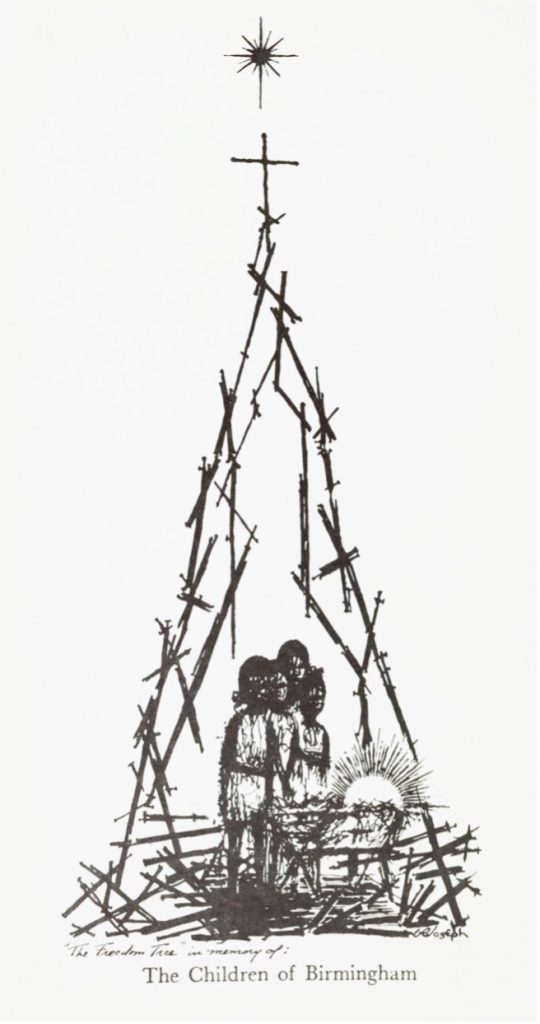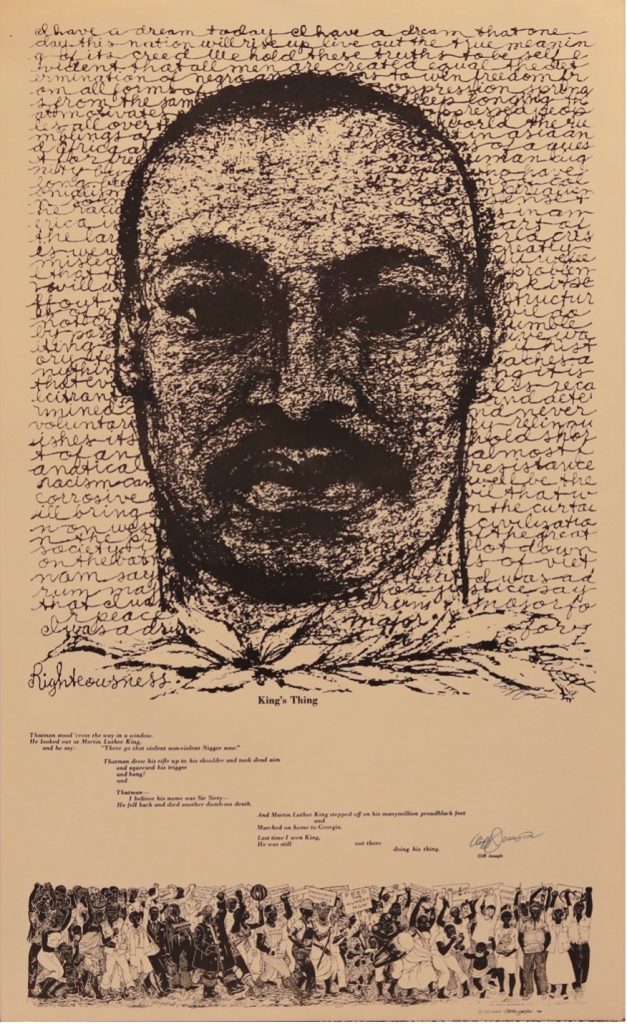January 17, 2022 | By Zachary D. Van Den Berg, MA, ATR-P, LPC-Associate
Today, we honor the life and legacy of Rev. Dr. Martin Luther King, Jr., whose nonviolent activism became central to the Civil Rights Movement. For art therapists, it is critical to note that Dr. King addressed the role of social scientists to assist the civil rights movement at the American Psychological Association’s 1967 Annual Convention. He called racism and its effects “gigantic in extent, and chaotic in detail.” And he urged social scientists to play active roles in challenging discrimination, white supremacy, and racial injustice—and “reaffirm our belief in building a democratic society” and “participate in the beauty of diversity.”
More than half a century later, we are still experiencing the crisis of violence against communities of color that Dr. King spoke about in his speech. We continue to see the lingering effects of racism in continued economic inequity and instability, higher mortality rates from the COVID-19 pandemic, and, most alarmingly, the contrasting responses of law enforcement and the criminal legal system to the overwhelmingly peaceful Black Lives Matters protesters and the armed white insurrectionists that stormed the Capital Building last year.
As art therapists—given our dual roles as both therapists and artists—we have a unique opportunity to address issues of injustice and discrimination, and in Dr. King’s words, to “tell it like it is.”
We can use our practice, knowledge, art, and our humility to craft and sustain opportunities for restorative action and radical healing across our areas of influence. And, we must continue to effect institutional and social change and not fall into performative gestures of solidarity.
Art therapists often work with the concept of the fear of the unknown, or “the Other,”— an elusive threat shadowed within each of us and the outside world beyond our experience. In the therapeutic art studio, art gives the artist and witness(es) an opportunity to come into relationship with these anxieties, misperceptions, and fears and imagine a place where they can be assembled into a gestalt of utopic unity. This ability to make more just worlds within our studios alongside our clients should be extended beyond the privatized space of therapy and into the public sphere of social action.
As our political leaders continue to cast “the Other” as a figure of incommensurate difference, we must instead engage in, what Dr. King terms, “creative maladjustment”. Dr. King’s artful subversive method for resistance recognizes:
“…that there are some things in our society, some things in our world, to which we should never be adjusted. We must never adjust ourselves to racial discrimination and racial segregation. We must never adjust ourselves to religious bigotry. We must never adjust ourselves to economic conditions that take necessities from the many to give luxuries to the few. We must never adjust ourselves to the madness of militarism, and the self-defeating effects of physical violence .”
Dr. King and Cliff Joseph

The Children of Birmingham, 1964, Artist: Cliff Joseph, Source: Tyler Fine Art
Dr. King’s call for creative maladjustment aligns with the “sacred function” of art as articulated by art therapy pioneer of color, Cliff Joseph. Joseph was present for Dr. King’s “I Have a Dream” speech at the March on Washington in 1963. He spoke of the experience: “I was so moved…I decided I would get out of commercial art…if I hadn’t had the inspiration that I got through the civil rights movement, I might have remained there, but this really awakened me.”
Dr. King’s “maladaptive creativity” was paralleled in Joseph’s “creative communication.” Joseph understood that “art has a sacred function, as a vital expressive power which can inspire humanity to expose and confront the dehumanizing, life-destroying forces of our time, and set into motion creative life-respecting alternatives.”
In response to the 1963 Ku Klux Klan bombing of Birmingham’s 16th Street Baptist Church, Joseph created a lithograph depicting a Christmas creche arranged from the debris of the bombing, entitled The Children of Birmingham. He then printed the piece on Christmas cards and sent them to Dr. King to be used for fundraising. Dr. King responded to Joseph in a letter:
“I was deeply impressed and very grateful for your generous gesture…. It was especially gratifying since I have always felt, since I first saw it, that your art expressed the meaning and sacrifice of our struggle.”
After Dr. King’s assassination, Joseph created a lithograph, King’s Thing, which depicts MLK with his speech emblazed on the background. Dr. Barbara Fish writes, “Joseph used his art as a powerful cultural communication that reflected both his reactions to the speech and to the circumstances described by the clients who he cared for in the hospital psychiatric unit where he worked.”

King’s Thing, 1986, Artist: Cliff Joseph, Source: Aaron Galleries
Joseph understood creative communication as our ethical responsibility as artists and advocates for change. He believed that:
“We cannot separate ourselves from the political process which will decide our ultimate fate. Our work is political, regardless of pretentions to purity. It supports the status quo; it questions it; it condemns it; and, if our work transcends the present world, we must struggle to make this transcendence a possibility for all.”
So today, as we honor Dr. Martin Luther King, Jr., let’s embrace the power of art to make alternative social worlds that are grounded in justice, in humility, and in hope.
Zachary D. Van Den Berg
 Zachary D. Van Den Berg, MA, ATR-P, LPC-Associate has an MA in counseling/art therapy from Adler University and a BFA from the School of the Art Institute. He is past-president of the Adler art therapy student association, founder of the international online forums Art Therapy Students Associated and Coalition for Queer Creative Arts Therapies, current chair of the multicultural committee of the AATA, and creative director of the Expressive Media Film Library. He works at CommunityArts, LLC, a group art therapy and counseling practice in Austin, TX.
Zachary D. Van Den Berg, MA, ATR-P, LPC-Associate has an MA in counseling/art therapy from Adler University and a BFA from the School of the Art Institute. He is past-president of the Adler art therapy student association, founder of the international online forums Art Therapy Students Associated and Coalition for Queer Creative Arts Therapies, current chair of the multicultural committee of the AATA, and creative director of the Expressive Media Film Library. He works at CommunityArts, LLC, a group art therapy and counseling practice in Austin, TX.
The views and opinions expressed by guest authors in this blog do not necessarily reflect the official policy or position of AATA.
